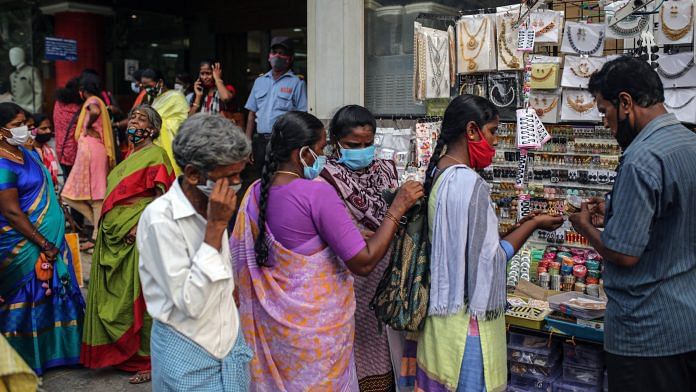New Delhi: The majority of the SARS-CoV-2 virus is inactivated within 10 minutes of aerosolisation, with a decrease in infectivity to about 10 per cent of the starting value over 20 minutes — making transmission less likely over long distances — according to a study.
In the study, uploaded on medrXiv on 10 January and yet to be peer-reviewed, researchers from the University of Bristol report that there is a rapid decline in infectivity within a few seconds to minutes of aerosol generation. Until now, the general consensus was that SARS-CoV-2 in the aerosol phase deteriorates over the course of one-two hours, if not longer.
It’s now well documented that the SAR-CoV-2 virus spreads through aerosols — tiny droplets released when we exhale, cough, sneeze, talk or sing — that tend to remain suspended in the air for a long period of time.
The study’s findings reiterate the fact that the virus is primarily spread over short distances.
“Often, the assumption is that short-distance transmission is caused by large droplets that fall to the ground more quickly and therefore do not travel as far,” the paper says.
However, the research provides an alternative explanation for a short transmission distance.
The team notes that the rapid loss of infectivity makes transmission of the infection decreasingly likely as distance from the particle source is increased — even if the particles that contain the virus are small and able to travel long distances.
The findings also suggest that dry air may help to limit overall exposure in closed spaces, with infectivity decreasing more rapidly when humidity is low.
Moreover, the study also indicates that the presence of high levels of CO2 within a room are a clear sign of poor ventilation and high risk of transmission. This means that CO2 monitors can be used to determine the relative risk of Covid-19 transmission in various settings.
“Not only is elevated CO2 an indication of a densely occupied, poorly ventilated space, but it could also be indicative of an environment in which SARS-CoV-2 is more stable in the air,” the team said.
Also read: India’s daily growth rate of Covid cases has plateaued at 34.9%, claims Cambridge tracker
‘Infectivity falls to 54% within 5 seconds in low humidity’
According to the researchers, measuring the changes in airborne viral infectivity with time is crucial to improving our understanding of the influence of environmental and biological parameters on the transmission of viruses.
To understand how aerosols change in response to the surrounding environment seconds after being exhaled, the team used an aerosol generator and studied how relative humidity affected the droplets.
They found that a decrease in infectivity at low humidity occurs almost immediately, falling to an average of 54 per cent within five seconds of generation. However, the virus infectivity then remains more stable, only decreasing by an average of 19 per cent over the next five minutes.
At high humidity, the reduction in infectivity is more gradual, with a steady loss of 48 per cent within the first five minutes.
The rate of decay in survival appears to plateau after 10 minutes, irrespective of the humidity levels.
The researchers said that further research will be required to explore for how long this plateau continues, and how much of the virus-laden aerosol survives after 20 minutes.
The team said that the infectivity decreases as the aerosols, reacting with CO2 within the droplets, become too acidic for the virus to survive, especially in high-humidity conditions. In low humidity, the salts within the droplets crystallise, reducing the infectivity of the virus.
Further research is also needed to confirm the degree to which acidity is involved in the airborne loss of SARS-CoV-2 infectivity at high humidity, and to determine the exact mechanism by which the pH rise deactivates the virus.
(Edited by Rohan Manoj)
Also read: ‘Deltacron is non-variant of no concern’: Why experts aren’t worried about Delta-Omicron ‘hybrid’



